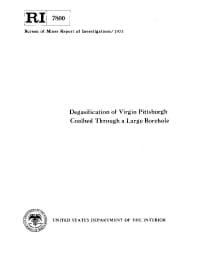Mining Publication: Degasification of Virgin Pittsburgh Coalbed through a Large Borehole
Original creation date: January 1973
Authors: HH Fields, S Krickovic, A Sainato, MG Zabetakis
NIOSHTIC2 Number: 10000671
Pittsburgh, PA: U.S. Department of the Interior, Bureau of Mines, NTIS No. PB-224570, RI 7800, 1973 Jan; :1-27
The Bureau of Mines is in the process of degasifying a virgin area in northern West Virginia from the base of an 839-foot-deep vertical borehole. An in situ gas pressure hole 199 feet long, and seven degasification holes ranging in depth from 500 to 850 feet (average 618 feet) were drilled in an 8-foot-thick virgin Pittsburgh coalbed from the enlarged (14-foot diameter) bottom of this borehole. The in situ pressure at the back end of the hole and the range of gas and water flows from degasification holes as they were completed and closed off were 203 psi, 79,000 to 257,000 cfd (average 160,000 cfd), and 5 to 8 gpm per hole (average 6.8 Gpm), respectively. Twenty-four hours after the seven holes were connected through individual water traps to a common collector for natural venting of the gas through pipes to the atmosphere, the total gas and water flows and the in situ pressure dropped, respectively, to 971,000 cfd, 1.3 Gpm, and 18 psi. Eighty days later the corresponding values dropped to 529,000 cfd, 0.50 Gpm, and 13 psi. After 180 days of degasification, 91 million cubic feet of gas had been removed from the affected virgin area. This represents 60 to 70 percent of the gas calculated to be contained in the area of coal affected by the holes.

NIOSHTIC2 Number: 10000671
Pittsburgh, PA: U.S. Department of the Interior, Bureau of Mines, NTIS No. PB-224570, RI 7800, 1973 Jan; :1-27
- Degasification and Production of Natural Gas From an Air Shaft in the Pittsburgh Coalbed
- Degasification System Selection for U.S. Longwall Mines Using an Expert Classification System
- Drainage of Methane From the Overlying Pocahontas No. 4 Coalbed From Workings in the Pocahontas No. 3 Coalbed
- Explosion Pressure Design Criteria for New Seals in U.S. Coal Mines
- A Gas Pressure-Based Drift Round Blast Design Methodology
- Measuring Formation Pressures and the Degree of Gas Drainage in a Large Coalbed Gas Drainage Field
- Methane Emissions from Four Working Places in the Beckley Mine, Raleigh County, W. Va.
- Rotary Drilling Techniques Used in the Beckley Coalbed
- Tying Acceleration and GPS Location Information Together To Create a Mine Management Tool
- Use of Vertical Boreholes for Assisting Ventilation of Longwall Gob Areas